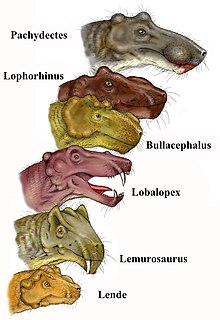| Bullacephalus Temporal range: Late Permian
| |
|---|---|

| |
| Scientific classification | |
| Domain: | Eukaryota |
| Kingdom: | Animalia |
| Phylum: | Chordata |
| Clade: | Synapsida |
| Clade: | Therapsida |
| Suborder: | †Biarmosuchia |
| Family: | †Burnetiidae |
| Genus: | †Bullacephalus Rubidge and Kitching, 2003 |
| Species: | †B. jacksoni
|
| Binomial name | |
| †Bullacephalus jacksoni Rubidge and Kitching, 2003
| |
Bullacephalus is an extinct genus of biarmosuchian therapsids belonging to the family Burnetiidae. The type species B. jacksoni was named in 2003. It is known from a relatively complete skull and lower jaw, discovered in the Late Permian Tapinocephalus Assemblage Zone of the Beaufort Group of South Africa.[1] This genus of therapsida lived during the Late Permian period, approximately 250 million years ago.
The name Bullacephalus comes from the Latin words "bullatus," meaning "bossed" or "knobbed," and "cephalus," meaning "head." This name refers to the distinctive bony knob on the top of the therapsid's skull, which contributes to the history of this genus. This stem based taxon includes Ictidorhinus or Hippasaurs. Bullacephalus can even be characterized as having "skull moderately to greatly pachyostotic; swollen boss present above the postorbital bar formed by the postfrontal and postorbital; deep linear sculpturing of the snout; exclusion of the jugal from the lateral temporal fenestra".[2] [3][4] Further research into the morphology, phylogenetics, and ecology of Bullacephalus and other Burnetiamorpha will likely continue to yield insights into the evolution of therapsids and the complex history of life on Earth.
- ^ Rubidge, Bruce S.; Kitching, James W. (2003-11-24). "A new burnetiamorph (Therapsida: Biarmosuchia) from the Lower Beaufort Group of South Africa". Palaeontology. 46 (1): 199–210. doi:10.1111/1475-4983.00294. ISSN 0031-0239.
- ^ Day, Michael; Rubidge, Bruce; Abdala, Fernando (2016). "A new mid-Permian burnetiamorph therapsid from the Main Karoo Basin of South Africa and a phylogenetic review of Burnetiamorpha". Acta Palaeontologica Polonica. 61. doi:10.4202/app.00296.2016. ISSN 0567-7920.
- ^ Rubidge, Bruce S.; Kitching, James W. (January 2003). "A new burnetiamorph (Therapsida: Biarmosuchia) from the Lower Beaufort Group of South Africa". Palaeontology. 46 (1): 199–210. doi:10.1111/1475-4983.00294. ISSN 0031-0239.
- ^ Liu, Jun; Rubidge, Bruce; Li, Jinling (2009-07-29). "A new specimen of Biseridens qilianicus indicates its phylogenetic position as the most basal anomodont". Proceedings of the Royal Society B: Biological Sciences. 277 (1679): 285–292. doi:10.1098/rspb.2009.0883. ISSN 0962-8452. PMC 2842672. PMID 19640887.